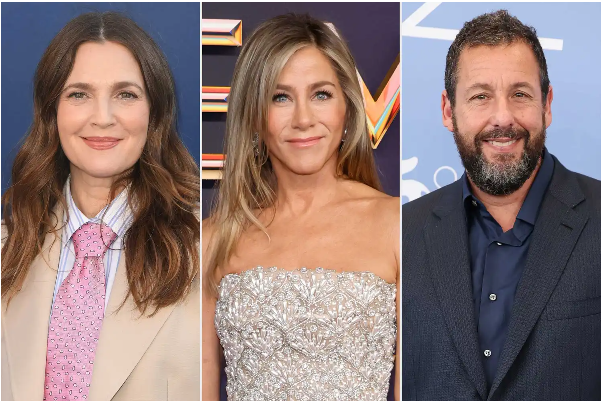Movies
Drew Barrymore’s Dream Reunion: Imagining a ‘Death Becomes Her’ Remake with Adam Sandler and Jennifer Aniston
1. A Cult Classic Reimagined: Why ‘Death Becomes Her’ Still Matters
A whimsical fantasy of vanity, rivalry, and surreal immortality, Death Becomes Her debuted in 1992 and quickly became a cult classic. Its striking blend of dark satire and groundbreaking visual effects—highlighting the extremes of aging and beauty—made it a standout in cinema history. The story follows aging actress Madeline and her rival Helen as they drink a potion granting eternal youth, only to find that immortality comes with gruesome side effects. Its biting commentary on vanity resonates today more than ever, as society continues to grapple with beauty standards and the desire to defy time.
Drew Barrymore has recently sparked excitement by expressing her desire to reimagine this dark comedy for a modern audience. On her daytime show, she casually mentioned—between humorous pitches and nostalgic reflections—that a remake starring herself, long-time collaborators Adam Sandler and Jennifer Aniston, would be nothing short of a fan-pleasing revival. It’s imaginative, enticing, and rooted in the playful camaraderie that audiences have cherished for decades.
A remake wouldn’t just be a rehash of the original; it would be a tribute to its legacy with modern twist. And with Barrymore steering the conversation, the idea carries both creative spirit and star-powered potential.

2. The Reunion We Didn’t Know We Needed: Barrymore, Sandler, and Aniston
Few on-screen trios have inspired quite as much affection as Drew Barrymore and Adam Sandler. Their co-starring roles in romantic comedies—The Wedding Singer, 50 First Dates, and Blended—crafted some of the most endearing cinematic pairings of the 1990s and 2000s. Their chemistry, grounded in warmth and mutual respect rather than overt romance, endeared them to millions. Barrymore has often described their on-screen collaboration not just as professional synergy, but as genuine friendship.
Jennifer Aniston enters this conversation naturally. She has shared the screen with Barrymore in ensemble films like He’s Just Not That Into You, and has appeared opposite Sandler in multiple titles (Just Go With It, Murder Mystery, Murder Mystery 2). Through their intersecting acting paths, these three actors have demonstrated a shared comedic sensibility.
Barrymore’s nostalgic enthusiasm for a project featuring all three of them stems from fondness and familiarity, but also from a place of creative trust. She’s joked about a Three’s Company reboot, too—but her focus remains on Death Becomes Her. Her point, perhaps, reflects more than comic potential; it’s about capturing a beloved tone, an ensemble dynamic rooted in deep personal connections.
Their bond isn’t just public chatter; as reported, they talk frequently, are close friends, and share a desire to collaborate again in meaningful—and playful—ways. A remake could fulfill both a career desire and a genuine creative longing.
3. The Remake’s Promise: Narrative Evolution Meets Nostalgia
Remakes thrive or flounder based on their ability to honor the original while offering fresh perspective. Death Becomes Her thrives on satirical exaggeration—a cautionary dark comedy wrapped in glittery aesthetics. In its original form, it ambled between biting humor and grotesque decadence, with actresses competing in a literal battle against aging.
To imagine Barrymore, Sandler, and Aniston in such roles opens myriad possibilities. Who among them plays the vain star turned immortal? Who becomes the rival? Sandler, known for his softer, often goofy persona, could offer a surprising counter to Barrymore’s energy as a fading star. Aniston’s grounded, relatable charisma could present a third dynamic—perhaps the initially overlooked character who diagrams revenge or reinvention.
Beyond casting, updating the film’s themes to speak to contemporary issues—social media’s effect on identity, cosmetic obsession, the gig economy’s impact on aging performers—could underscore its relevance. A remake isn’t just about laughs; it is about culture, vanity, identity, and gender, reframed for a digital era.
Barrymore’s interest isn’t based only on romantic nostalgia—it’s rooted in potential cinematic richness. A modern version could lure audiences both with affectionate callbacks and pitch-black new commentary.
4. Barrymore at the Helm: Host, Producer, and Pioneer
One guarantee: Drew Barrymore brings more than a star name to the project. As a daytime television host and media figure, she commands creative momentum and audience trust. Her prior success with reviving legacy material—most notably as a producer and star of the Charlie’s Angels films in the early 2000s—demonstrates her eye for reboots that resonate and entertain.
Barrymore’s talk show also offers her a platform to pitch ideas and test audience interest. When she floated the Death Becomes Her concept on air, she wasn’t just joking—she was surfacing a dream project, inviting collective imagination. That kind of open-hearted ambition can drive momentum among producers, studios, and collaborators.
As both talent and producer, Barrymore can shape narrative direction, casting, tone, and marketing. Her existing relationships with Sandler and Aniston make the idea logistically feasible. The trio could collectively harness their nostalgic brand while fostering a refreshed cinematic identity.
If the right script, tone, and production team come together, Barrymore could lead a film that honors legacy and cinephile affection while pushing comedic boundaries.
5. From Daytime TV Dream to Silver-Screen Reality
Is a Death Becomes Her remake with Barrymore, Sandler, and Aniston just a pipe dream, or a cinematic promise? The answer lies somewhere between ambition and timing.
Barrymore’s mention—playful yet pointed—was not a mere quip. She’s expressed desire, nostalgia, and readiness. She’s confident, confident enough to say it on air, and eager enough to keep pushing. The only missing element is the right script, right financing, and the right moment.
For a studio, the concept offers strong appeal: recognizable IP, beloved actors with proven chemistry, cross-generational nostalgia, potential for social media buzz, and built-in star power. For audiences, it signals levity, warmth, and something both familiar and surprising.
If realized, the project could become a cultural touchstone of sorts—an affectionate revival from three genre-familiar yet unexpected players. More than a comedy, it could be a statement: revisiting past icons isn’t just sentimental—it’s about re-examining societal obsessions through new eyes.
Barrymore made the idea known on her show. What remains is whether that spark catches—and whether a new generation will witness Death Becomes Her anew, guided by three friends who know how to play with aging, absurdity, and affection.
From: Candourroyaltees
